To maintain an effective root cellar, you'll need to follow ten critical storage rules. Keep temperatures between 32-40°F (0-4°C) and humidity at 85-95% for most produce. Install proper ventilation with low intake and high exhaust vents for ideal airflow. Use appropriate storage containers and organize crops based on their specific needs, keeping ethylene-producing fruits separate. Prevent pests with natural barriers and regular inspections. Monitor your stored items weekly, removing any spoiled produce promptly. Position your cellar in a cool, shaded location and prepare for seasonal changes. These fundamental principles will help you master the art of long-term food preservation.
Temperature Control Fundamentals
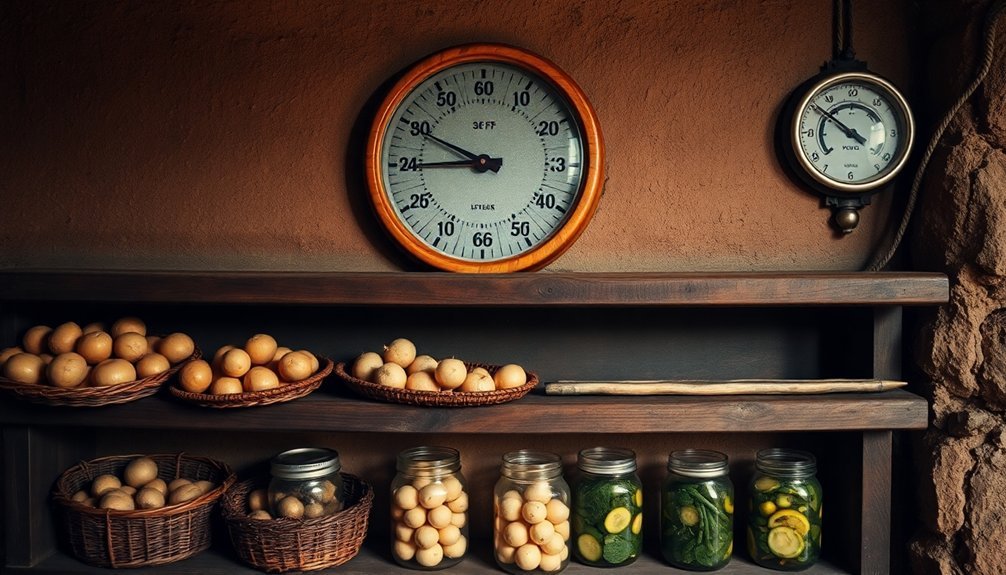
Four key elements make up effective temperature control in a root cellar: proper range, location, insulation, and ventilation. You'll need to maintain temperatures between 32-40°F (0-4°C) to enhance produce storage life. This range keeps your vegetables from sprouting or decaying while preventing freezing damage.
Choose a cool, shaded location, preferably a north-facing slope, to take advantage of natural temperature regulation. Traditional methods have proven this approach effective for centuries. You'll want to incorporate proper insulation using materials like straw bales, foam board, or earth berming. If you're building into a hillside, you'll benefit from the earth's natural insulating properties.
Don't overlook ventilation – it's essential for controlling temperature and preventing ethylene gas buildup. Install vents near the floor and ceiling to create natural airflow, letting warm air escape while drawing in cooler air. Consider opening vents at night to capture the coolest air.
Monitor your cellar's temperature regularly using thermometers or remote readouts. You'll need to adjust ventilation and insulation throughout the season to maintain ideal conditions.
Remove any spoiled produce promptly to prevent temperature fluctuations and protect your stored crops.
Humidity Management Basics
You'll need to monitor your root cellar's humidity levels regularly with a hygrometer to maintain the ideal 85-95% range that most produce requires.
To boost humidity naturally, you can install a dirt floor, add containers of water, or use damp materials like burlap or sawdust to pack your vegetables.
Regular moisture checks and adjustments, combined with proper ventilation, will help prevent both harmful drying and excessive dampness that could lead to rot.
Temperature monitoring between 32-40°F is essential since both temperature and humidity work together to create optimal storage conditions.
Moisture Control Best Practices
Maintaining proper humidity levels in your root cellar is essential for preserving fresh produce throughout the storage season.
You'll need different humidity levels for various types of produce: root crops and leafy vegetables thrive at 90-95%, while apples and potatoes prefer 80-90%. Garlic and onions need drier conditions at 60-70% humidity.
To increase moisture levels, start with a dirt floor covered in gravel to retain natural moisture. You can place water-filled pans on the floor or use damp burlap bags over produce. For individual items, pack them in slightly damp sawdust or sand to prevent moisture loss. Regular monitoring of humidity levels helps maintain optimal storage conditions.
When humidity gets too high, improve ventilation and use desiccants like charcoal or rice to absorb excess moisture.
Watch for warning signs of improper humidity. High levels can cause mold and rot, while low humidity leads to shriveled, flavorless produce.
Keep temperatures between 32-40°F to complement your humidity control efforts. Don't forget to remove any spoiled items promptly, as they can affect nearby produce.
For cucumbers and sweet peppers, maintain slightly warmer conditions (40-50°F) with 85-90% humidity for short-term storage.
Measuring Humidity Levels
Precise humidity measurement forms the foundation of successful root cellar storage. You'll need reliable tools to monitor moisture levels effectively, such as a humidistat, hygrometer, or a combination thermostat-humidistat device. Digital thermometers with humidity readings are also practical options for maintaining appropriate conditions.
Your root cellar's humidity requirements will vary depending on what you're storing. Most produce thrives in humidity levels between 80-95%, with root vegetables and leafy greens needing the higher end of this range (90-95%). Fruits can tolerate slightly lower levels, around 80-90%.
Getting these measurements right is essential, as incorrect humidity can lead to either shriveled produce or harmful mold growth.
You'll want to check your humidity levels regularly and make necessary adjustments through ventilation control. If you notice readings outside the ideal range, you can use humidifiers or dehumidifiers to correct the situation.
It's smart to test your storage setup with small batches of produce first to guarantee your humidity management is effective. Keep the space clean and watch for signs of excessive moisture or mold, making adjustments as needed to maintain proper storage conditions.
Natural Humidity Boosting Methods
While monitoring humidity levels is essential, there are several natural ways to boost and control moisture in your root cellar without relying on electrical equipment.
Start by utilizing your floor's natural properties – a dirt floor retains more moisture than concrete or stone. You'll want to spread gravel over packed earth to maintain dampness while preventing waterlogged conditions.
Take advantage of your cellar's fullness, as stored vegetables naturally release moisture. Place pans of water on the floor to increase humidity through evaporation, and use damp burlap bags over produce to maintain consistent moisture levels. For individual vegetable storage, pack them in slightly moist sawdust or sand to reduce surface evaporation.
Your cellar's structure plays an important role in humidity control. Make sure you've covered the roof with 2-4 feet of earth and planted grass to help retain moisture.
Install proper drainage around the cellar to prevent waterlogging while maintaining natural dampness. Leave gaps between shelves and walls for proper air circulation, which helps distribute humidity evenly.
Remember to adjust ventilation as needed to prevent excessive condensation while maintaining the ideal 85-95% humidity range.
Proper Air Flow Systems
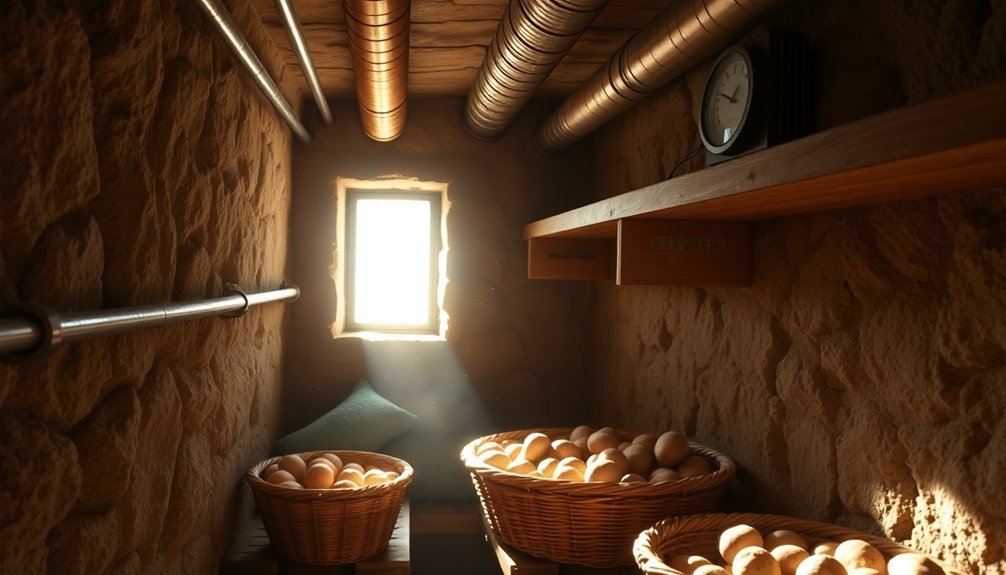
You'll need both intake and outlet vents strategically placed in your root cellar, with cold air entering through low-placed intakes and warm air escaping through ceiling-level outlets.
While passive airflow through natural convection can work effectively, you can boost circulation with a well-timed fan system when outside temperatures are cooler than the cellar's interior.
For peak performance, use 4-inch diameter ductwork and guarantee proper sealing capabilities for your vents, which you'll open in summer and seal tightly during winter months.
Ventilation System Design Basics
Setting up proper ventilation in your root cellar boils down to two essential components: inlet and outlet vents.
You'll need to position inlet vents near the floor to allow cool air entry, while outlet vents should be placed near the ceiling to release warm, humid air. For maximum effectiveness, place these vents on opposite sides of your cellar.
Your ventilation system will work best with vertical airflow through the ceiling, but if that's not possible, you can opt for horizontal ventilation using opposing walls.
Whatever layout you choose, make certain you're sealing your vents properly with packed cloth, expanding foam, or rubber gaskets to prevent unwanted air leaks.
To maintain ideal storage conditions, you'll want to open your vents at night when the air is coolest and close them during warmer daytime hours.
Consider installing a small electric fan in the exhaust vent to enhance airflow, and use wire racks on your shelves to improve air circulation around stored items.
Monitor your cellar's conditions using remote thermometers, so you won't need to open the door frequently and disrupt the carefully maintained environment.
Natural vs. Mechanical Flow
Choosing between natural and mechanical ventilation systems presents two distinct approaches to managing your root cellar's airflow.
Natural ventilation offers a cost-effective, environmentally friendly solution that works by utilizing wind patterns and pressure differences. You'll benefit from zero energy costs and minimal maintenance, but you'll need to accept less control over airflow conditions and weather dependencies.
Mechanical ventilation, while requiring an initial investment and ongoing energy costs, gives you precise control over your cellar's environment. You can maintain consistent airflow and humidity levels regardless of outdoor conditions, which is particularly valuable during extreme weather.
The system's customizable nature lets you adjust settings to match your specific storage needs.
When deciding between the two, consider your climate and storage requirements. If you're in an area with moderate temperatures and you don't mind adjusting ventilation manually, natural airflow might suffice.
However, if you're storing large quantities of produce or live in an area with challenging weather patterns, mechanical ventilation's reliability and control features could justify the additional cost.
Remember that mechanical systems also offer better air quality management through active circulation, which can extend your produce's shelf life.
Strategic Vent Placement Tips
While creating an effective root cellar environment depends on many factors, proper vent placement stands as the cornerstone of successful food storage.
You'll want to position your intake vents low to the ground where cool air naturally flows, while placing outlet vents near the ceiling to allow warm air and ethylene gas to escape. For peak efficiency, install these vents on opposite walls, creating a natural cross-flow that keeps your produce fresh.
When planning your vent installation, consider these critical steps:
- Select 3- or 4-inch diameter PVC pipes for peak airflow, adding protective bends to prevent rain infiltration.
- Install screens on both interior and exterior vent openings to block insects and rodents.
- Position vents to take advantage of northern exposure, where possible, to maintain cooler temperatures.
Remember to seal your vents properly during winter using expanding foam or rubber gaskets, but keep them open during summer months.
For the best results, you'll want to open vents overnight when temperatures are lowest. If you're working with an existing window, consider replacing the glass with an insulated panel that accommodates your ventilation needs.
Storage Container Selection
The success of your root cellar depends heavily upon the storage containers you select. You'll find several effective options, from simple plastic vessels to repurposed appliances, each offering unique benefits for your storage needs.
For a basic setup, plastic buckets and trash cans work well when insulated with straw or hay. If you're looking for a more robust solution, consider converting an old freezer or refrigerator into a storage unit, but don't forget to add ventilation holes and PVC pipes for proper air circulation.
Earthbags filled with soil provide an economical alternative that doesn't require digging. To maximize your storage efficiency, use stackable trays that allow air circulation and consider wooden containers with burlap covers to maintain proper humidity while blocking light.
When using plastic containers, drill drainage holes in the bottom to prevent moisture buildup. For smaller quantities, recycled tires can effectively protect your food from pests and excess moisture.
Remember to separate produce that releases ethylene gas from root vegetables by using different containers or compartments. Label your containers clearly and check them regularly to monitor the condition of your stored items.
Only store undamaged, clean produce to prevent premature spoilage.
Pest Prevention Strategies
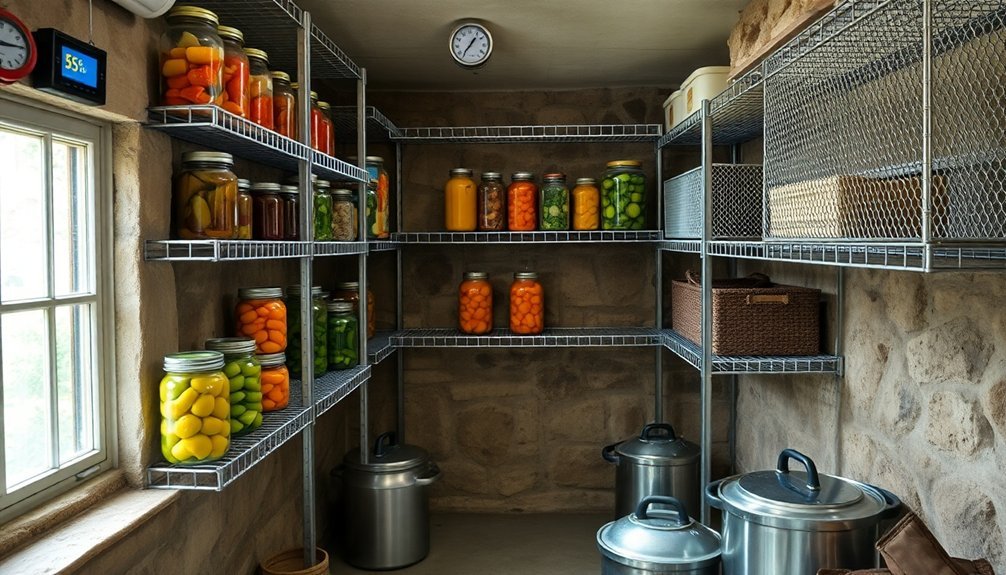
To protect your root cellar from unwanted visitors, start by creating natural barriers using peppermint oil, bay leaves, and diatomaceous earth around storage areas and entry points.
You'll want to carefully inspect and seal any gaps or cracks with caulk, while installing hardware cloth over ventilation openings to block rodents' access.
Installing sturdy shelving units and storing produce in breathable containers creates an additional defensive layer, making it harder for pests to reach your stored goods.
Natural Pest Barriers
Creating effective natural pest barriers stands at the forefront of root cellar maintenance.
You'll find that nature's own repellents offer powerful protection against unwanted visitors while keeping your stored produce safe and chemical-free. By strategically placing peppermint oil-soaked cotton balls around your cellar and revitalizing them regularly, you're creating an invisible barrier that mice won't cross.
Bay leaves, cloves, and garlic serve as your next line of defense. Place whole bay leaves in storage bins to ward off weevils and other insects, while hanging garlic bulbs and sprinkling ground cloves near entry points will deter larger pests. For enhanced protection, combine these with cayenne pepper.
To maximize your natural pest barrier strategy:
- Layer your defenses by combining multiple deterrents – use peppermint oil at ground level, bay leaves in storage containers, and garlic near shelving units.
- Create a perimeter defense by placing deterrents near all potential entry points, including small cracks and corners.
- Maintain regular inspections and rejuvenate your natural barriers weekly, as their effectiveness diminishes over time.
Remember to keep your storage containers airtight and use breathable materials like burlap sacks to minimize attractive food odors while maintaining proper airflow.
Rodent-Proof Entry Points
Securing your root cellar against rodents starts with five critical entry points that require immediate attention. You'll need to examine corners, pipes, vents, foundation cracks, and doorways with a flashlight to spot potential access points. Don't overlook small gaps – mice can squeeze through holes as tiny as a quarter inch in diameter.
| Entry Point | Common Issue | Solution |
|---|---|---|
| Corners | Hidden cracks | Steel wool + caulk |
| Pipes | Gap around edges | Metal collars + sealant |
| Vents | Open access | Fine mesh screens |
| Foundation | Wall cracks | Concrete patching |
| Doorways | Poor seals | Weatherstripping |
Once you've identified these vulnerable spots, use steel wool as your first line of defense – rodents hate chewing through it. Follow up with silicone-based caulk for a permanent seal. For foundation issues, apply concrete patch, and don't forget to secure your vents with fine mesh screens that allow airflow while blocking pests. Install tight-fitting covers on exhaust openings and guarantee your cellar door has proper weatherstripping. Remember to check these seals every season, as temperature changes can create new gaps.
Produce Organization Methods
Proper organization of your root cellar's produce can considerably extend storage life and prevent cross-contamination between different fruits and vegetables.
Install sturdy metal or plastic shelving along the walls, keeping them 16 inches deep and slightly separated from the wall for air circulation. You'll want to brace these shelves with scrap wood to guarantee they can handle the weight of your harvest.
When storing your produce, remember these essential rules:
- Place ethylene-producing fruits on upper shelves near vents, while keeping root vegetables and tubers at ground level to prevent premature ripening.
- Group fruits and vegetables with similar temperature and humidity needs together, using sealed containers for strong-smelling items.
- Don't wash your produce before storage – that protective layer of dirt actually helps fight disease.
Elevate your storage crates a few inches off the ground to promote airflow underneath.
Check your stored items every few weeks, removing any spoiled produce immediately.
You'll need to maintain high humidity levels (90-95%) and monitor the environment with a hygrometer.
Seasonal Preparation Guidelines
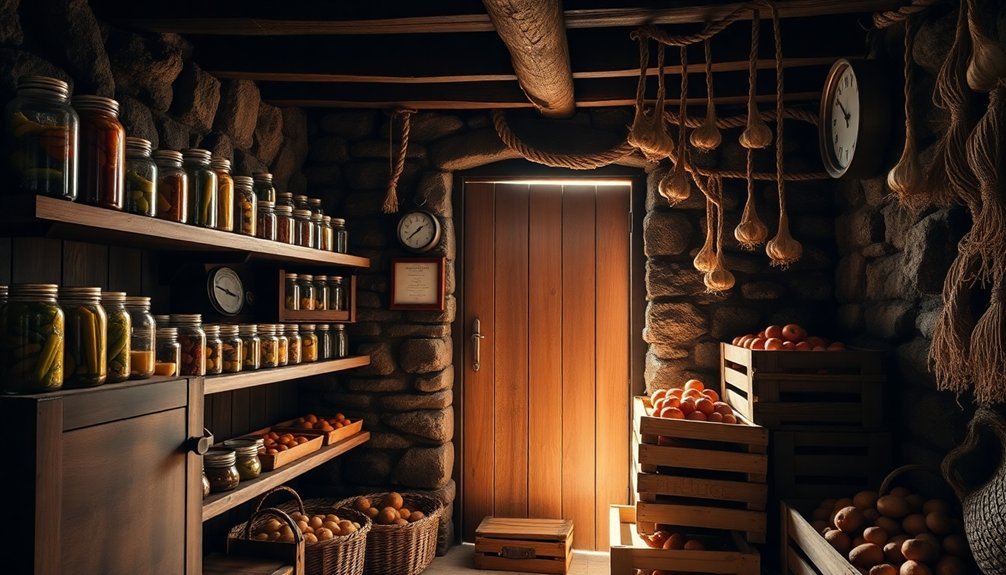
While a root cellar provides year-round storage, each season demands specific preparation to maximize its effectiveness. In spring, you'll need to plant storage-specific varieties of root vegetables like carrots, beets, and potatoes. Start by sowing broccoli and cabbage early, followed by root cellar carrots in late June.
During summer, focus on preserving crops through various methods. You can ferment early cabbage into sauerkraut and prepare herbs by making tinctures or dehydrating them. When fall arrives, harvest your main storage crops, ensuring you select only undamaged produce. Remember not to wash vegetables before storing them.
| Season | Key Activities | Storage Focus | Temperature | Humidity |
|---|---|---|---|---|
| Spring | Plant storage crops | Plan variety selection | 45-55°F | 65-75% |
| Summer | Preserve early harvest | Herb preparation | 55-65°F | 70-80% |
| Fall | Main crop harvest | Curing and storing | 40-45°F | 80-85% |
| Winter | Regular monitoring | Maintenance | 32-40°F | 85-95% |
| Early Spring | Inventory check | Space preparation | 35-45°F | 75-85% |
Throughout winter, you'll need to check your stored produce every few weeks, removing any spoiled items promptly. Monitor temperature and humidity levels regularly, adjusting ventilation as needed to maintain ideal storage conditions.
Crop Compatibility Planning
Beyond seasonal planning, successful root cellaring depends on smart crop grouping and placement.
You'll need to organize your crops based on their specific storage requirements and how they interact with each other. Some produce releases ethylene gas, which can speed up ripening and potentially spoil nearby crops, making proper separation vital.
When planning your root cellar layout, consider creating distinct zones for different storage conditions. Keep your root vegetables like carrots, beets, and parsnips in the coolest, most humid areas (32-40°F, 90-95% humidity).
Place onions, garlic, and winter squash in slightly warmer, drier spaces (50-60°F, 60-70% humidity).
For ideal storage success, follow these essential grouping rules:
- Store apples and pears separately from other produce, as they're heavy ethylene producers
- Group root vegetables together in damp storage mediums like sawdust or sand
- Keep onions and garlic in well-ventilated containers away from moisture-loving crops
Remember to position frequently accessed items near the front of your storage area and maintain clear pathways for regular monitoring and rotation.
Remove any spoiled produce immediately to protect the integrity of your stored crops.
Ventilation Design Requirements
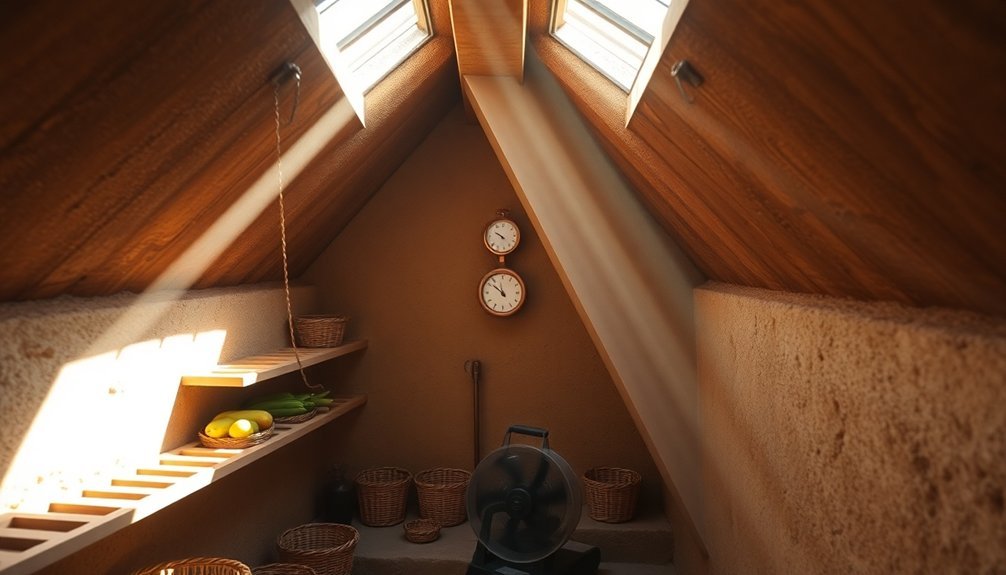
A well-designed ventilation system serves as the lungs of your root cellar. You'll need to position intake vents low to the ground and outlet vents near the ceiling on opposite walls for ideal airflow. For smaller spaces, two 3-4 inch diameter vents will suffice, while larger cellars require four vents.
Use durable Schedule 40 PVC tubing for your vents, and don't forget to screen them against pests. You'll want to seal the edges where vents meet the walls to guarantee proper closure during winter months.
| Ventilation Issue | Solution |
|---|---|
| Excess Humidity | Keep vents open in summer |
| Cold Winter Air | Seal vents tightly |
| Pest Control | Install mesh screens |
| Air Circulation | Place vents on opposite walls |
| Temperature Control | Adjust vent openings seasonally |
Proper ventilation prevents ethylene gas buildup and manages humidity levels, essential for preventing premature spoilage. You'll need to maintain high humidity while avoiding stagnant air. During extreme weather, you can temporarily plug vents or relocate stored items away from them. Remember not to connect any standard HVAC systems to your root cellar, and insulate any overhead ductwork to prevent unwanted heat transfer.
Monitoring and Maintenance Procedures
Setting up proper ventilation is just the first step – you'll need to actively monitor your root cellar's conditions to guarantee long-term storage success.
Keep thermometers throughout the space to maintain temperatures between 32°F and 40°F, and make sure humidity levels stay between 85-95% for ideal vegetable storage. Remember that warm air rises, so you'll want to check temperatures at different heights.
Make these essential monitoring tasks part of your routine:
- Check stored produce at least weekly for signs of spoilage, removing any affected items immediately to prevent decay from spreading to healthy vegetables.
- Monitor ethylene gas levels by keeping ethylene-producing vegetables separate from sensitive ones, using ventilated containers or storing them near vents.
- Inspect your insulation and ventilation systems regularly, making adjustments as needed to maintain consistent conditions.
Store similar vegetables together and use plastic containers with small holes to control moisture and ethylene gas.
Don't forget to elevate your storage crates for proper air circulation. If you're in an area with cold winters, you can use homemade ice during warmer months to help maintain cool temperatures throughout the year.
Frequently Asked Questions
Can a Basement Be Converted Into an Effective Root Cellar?
Yes, you can convert your basement into an effective root cellar by insulating the walls, maintaining proper ventilation, and choosing a northeast or northwest corner where you'll achieve ideal temperature and humidity control.
How Long Does It Take for a New Root Cellar to Stabilize?
You'll need 2-4 weeks for your new root cellar to stabilize. During this period, monitor temperature and humidity daily, making adjustments to ventilation and insulation until you achieve consistent ideal conditions.
What's the Best Location for a Root Cellar Door?
You'll want your root cellar door facing north or northeast to minimize sun exposure. Position it slightly elevated to prevent water entry, and guarantee it's easily accessible while maintaining proper drainage around the entryway.
Should Electric Backup Systems Be Installed for Temperature Regulation?
Yes, you'll want electric backup systems to regulate temperature. You can protect your stored produce during power outages and maintain consistent conditions. It's a worthwhile investment for your root cellar's reliability.
Can Multiple Families Share One Root Cellar Effectively?
Yes, you'll find that multiple families can effectively share a root cellar when you establish clear organization systems, divide responsibilities, and maintain strong communication. It's a great way to build community connections.
In Summary
You'll find that mastering these root cellar essentials transforms your storage capabilities year-round. By maintaining proper temperature, humidity, and airflow while using suitable containers and pest control, you're setting yourself up for long-term storage success. Don't forget to regularly monitor conditions and adjust your setup as needed. With these ten fundamental rules in place, you're ready to preserve your harvest effectively and reduce food waste.

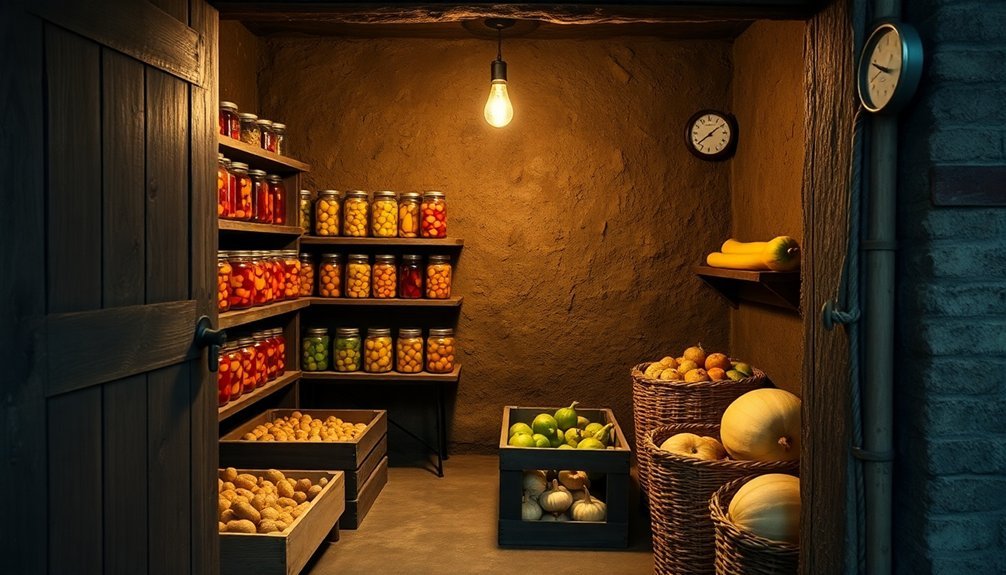



Leave a Reply